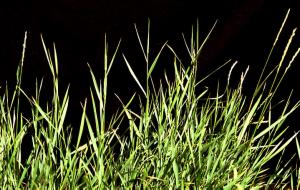|
Biology and Management of Quackgrass |
|
CONTENTS |
Quackgrass is a perennial reproducing by seed and underground rootstocks. Rootstocks vary from 2 to 8 inches in depth, depending on soil type and soil treatment. Individual rootstocks live only two summers and one winter but new ones develop from buds in the axils of reduced leaves. Roots arise only at nodes. Erect stems 1 to 3 feet tall arise from shallow below-ground rhizomes. Leaf blades are flat and have small claw-like auricles that wrap around the leaf sheath. Short spikelets arranged in two rows. Quackgrass seeds may lie dormant in the soil for several years. Cultivation often spreads quackgrass infestations by breaking up and dragging rhizomes. Pieces of rhizomes, as small as 1 inch, can establish new plants. Impact on Yield: Dense stands of quackgrass are often over 3 ft tall and severely reduce mint yields by competing for light, nutrients, and water. If not controlled, quackgrass can result in a complete loss of mint in heavily infested areas of the field. Herbicide Control Notes:
|

